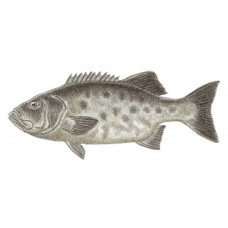Latin name
Stereolepis gigas
Other names
California black sea bass, California jewfish, giant bass, black, black sea bass; French: bar gigantesque; Japanese: kokuchi-ishinagi, ishinagi-zoku; Spanish: lubina gigante.
Identification
The body is elongated and has dorsal spines that enter the groove on the back. Greenish-brown or black, the giant sea bass has black or transparent fins, except for the pelvic fins, which appear lighter because of the white membrane between the black spines. There is usually a white band on the throat and under the tail, and the membranes between the rays are also light. Young fish are mottled with conspicuous dark spots and a few pale yellow spots on the predominantly brick-red body. These markings occasionally occur in fish weighing up to 25 pounds or more. The first dorsal fin is separated from the second by a single notch, it is very low and has 11 spines, while the second is taller and has 10 soft rays.
Distribution
Giant sea bass is inhabited in the tropical and subtropical coastal waters of the northeast Pacific off the coast of California and Mexico, specifically from the Gulf of California southward to Humboldt Bay and Guadalupe Island. These fish were in short supply in California waters, but their numbers increased in the 1990s due to a moratorium on keeping them.
Habitat
Inhabiting coastal waters, giant sea basses live on the bottom, preferring the hard, rocky bottom around kelp beds. Juveniles live at depths of 6 to 15 fathoms, while larger specimens usually live at depths of 15 to 25 fathoms.
Size
Reaches maturity by age 11-12 and weighs about 50 pounds, although it has been known to weigh over 600 pounds and be over 7 feet long. The world record set for all tackle is 563 pounds 8 ounces. Specimens between 100 and 200 pounds are the most common, smaller fish are rare. Some of the largest specimens are believed to be 75 years old or more.
Life history and Behavior
No information
Food and feeding habits
The diet of the giant sea bass includes crustaceans and a variety of fish. Anchovies and croakers are a major food source off the California coast. Mackerel, muskrat, whitefish, sand bass, and several species of crabs are also favored. Although these bulky fish seem slow and unwieldy, they quickly catch up with the nimble bonito in pursuit.
Reproduction
No information
| Classification | |
| Phylum | Chordata |
| Class | Actinopterygii |
| Squad | Perciformes |
| Family | Polyprionidae |
| Genus | Stereolepis |
| Species | S. gigas |
| Features | |
| Conservation status | Critically Endangered |
| Habitat | Pelagic |
| Life span, years | 100 |
| Maximum body weight, kg | 381 |
| Maximum length, cm | 275 |
| Sailing speed, m/s | No information |
| Threat to people | Edible |
| Way of eating | Predator |




